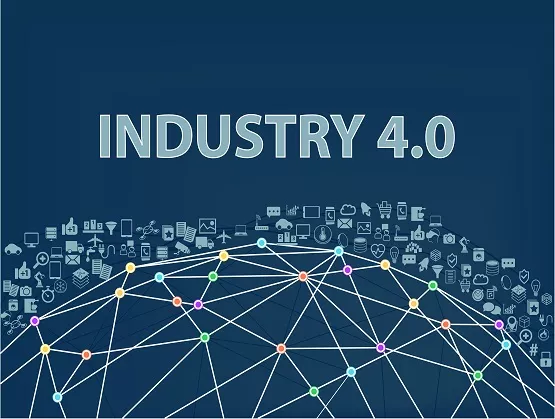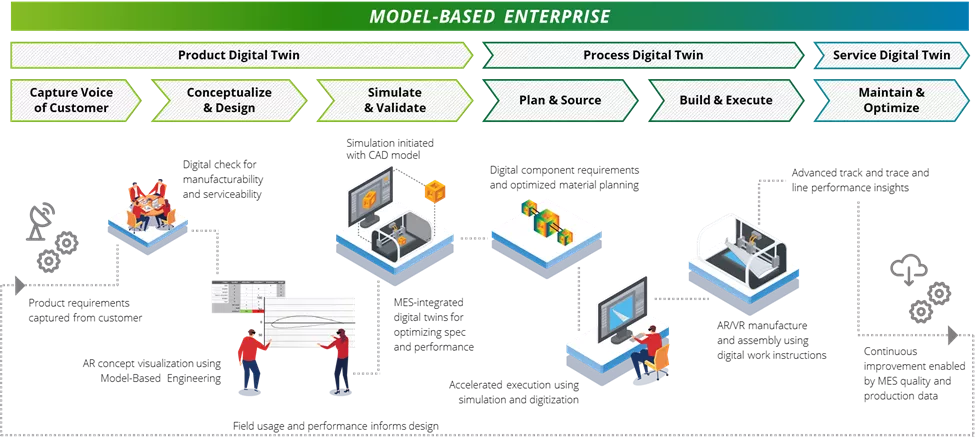
Connecting product development to manufacturing to the field in the semiconductor equipment industry by becoming a Model-Based Enterprise
Manufacturers across many industries, including the semiconductor equipment industry, are facing pressure to dramatically reduce product development cycle and production ramp times while also enhancing product quality and reliability. This challenge is complicated when multiple configurations are deployed and then maintained, enhanced and upgraded in the field.
Buzzwords like digital thread, digital twin, smart manufacturing, Industry 4.0, and digital supply networks point toward a fusion of process, technology, data, and talent that promise the game-changing outcomes needed to address these challenges. Yet, there remains uncertainty about how these various elements come together into a cohesive approach across the product lifecycle.
 One such approach involves establishing a Model-Based Enterprise (MBE), with alignment across organizational silos, processes, and technologies. Too often, however, an effort to transform to an MBE is frustrated by “random acts of digital” that pursue implementation of certain digital technologies but fall far short of delivering value. What is needed instead is a deeper understanding of the characteristics of a true MBE and the tools and approaches to transform the organization, processes, and data to an MBE and thrive in the marketplace.
One such approach involves establishing a Model-Based Enterprise (MBE), with alignment across organizational silos, processes, and technologies. Too often, however, an effort to transform to an MBE is frustrated by “random acts of digital” that pursue implementation of certain digital technologies but fall far short of delivering value. What is needed instead is a deeper understanding of the characteristics of a true MBE and the tools and approaches to transform the organization, processes, and data to an MBE and thrive in the marketplace.
Elements of a Model-Based Enterprise
Modeling in engineering is not new, but what’s emerging are MBEs that comprise digital models connected upstream and downstream over the entire product lifecycle, from a product’s conception and development through its production and end market installation and use. At the heart of such MBEs are digital threads—integrated sets of processes executed within an interconnected technology ecosystem that drive the end-to-end product lifecycle and provide MBE data traceability front to back. A digital thread in the MBE environment includes all of the process, data, and system capabilities that enable digital representations of the product lifecycle stages, or digital twins, of which there are three primary types:
- The product digital twin is a virtual or simulated representation of the product and each of its components and configurations. While most manufacturers manage engineering models with CAD/CAE solutions, just 15% use product digital twins. Leaders in this space have seized a competitive advantage in product development and accelerated engineering. Yet, becoming a true MBE requires more than product digital twins.
- The process digital twin is a model of the manufacturing equipment, processes, and the workforce required to carry out related operations. The process digital twin represents the operation of the physical factory floor and its assets, complete with workflows and instructions that describe how the manufacturing processes are performed. A process digital twin relies on data from the product digital twin and allows the enterprise to build according to a product plan and predict what may happen on the factory floor. About 5% of enterprises use process digital twins.
- After production, a service digital twin represents the installation, use, maintenance, and repair of each product operating in the end market. The service digital twin is informed by product and process digital twins to facilitate adjustments and enhancements based on real-world data. Less than 5% of manufacturers use service digital twins, which is perhaps expected due to their reliance on the existence of the product and process digital twins.
When underlying data (e.g., models, specifications, and configurations) are standardized and integrated across a digital thread, an enterprise has the capacity to monitor and refine a product over the span of the thread while also injecting insights and improvements back into the thread. The result is that engineering and manufacturing and end customer usage feedback is continuous and efficient, achieving in weeks what once took months. Visibility into materials, costs, suppliers, and more enable the enterprise to pivot and keep production moving, even when dealing with unforeseen challenges. Real-time monitoring that synthesizes live data also helps reveal performance insights and end market issues (e.g., installation issues, quality issues, etc.) that allow improvements to the offerings and operations of the enterprise. While the manufacturing and product development benefits of an MBE may be clear, the path to becoming an MBE and achieving these benefits can be challenging.

Figure 1. Representative MBE end-to-end digital thread that connects product development, manufacturing, and the field (Source: Deloitte Development LLC, 2021)
Accelerating Transformation
New and emerging manufacturers have an opportunity to build toward their MBE vision without the historic data constraints legacy systems can impose. For more established manufacturers, such is more typical in the semiconductor equipment space, legacy technology and processes can present obstacles to an MBE transformation path. Stakeholders who have invested time and resources implementing certain enterprise platforms (e.g., CAD, PLM, ALM, MES, ERP, etc.) often look for how these can be used to enable a digital thread and digital twins over the enterprise. This limiting view frustrates a broader, more holistic opportunity to transform to an MBE and thrive in the marketplace. There is thereby a dual imperative to define a modernized and scalable end-to-end technology architecture for managing the MBE product data while also establishing a capabilities implementation roadmap that rapidly leads to MBE maturity.
To be successful in your MBE transformation, four core functional capabilities that enable a digital thread must be considered: digital engineering, industrial simulation, manufacturing execution, and real-time monitoring. Addressing each with optimized tools allows a manufacturer to rapidly move from strategy to reality. Recognizing the complexity of addressing these functional needs, Deloitte has developed preconfigured solutions to help expedite and enhance transformation across each of these core areas.
| Design with D-PLM | Simulate with D-Sim | Execute with D-MES | Monitor with D-IoT |
| Accelerates product and application lifecycle management transformations with a multi-phased approach, including a phased, multi-year PLM/ALM roadmap and business case. | Facilitates the ability to test and refine processes in a virtual environment, rapidly revealing the most efficient and effective industrial processes more quickly than is possible in a real-world environment. | Integrates pre-defined processes related to production planning, execution, tracking and tracing, quality management, data collection, and visualization, with integrations to PLM and ERP. | Delivers fast implementation of IoT capabilities that connect, collect, and analyze a broad scope of production data to drive quicker returns for high-impact areas while cultivating digital adoption. |
While many enterprises have various initiatives in model-based systems and manufacturing, few have tied them together with an end-to-end digital thread and set of data standards over the entire product life cycle. The foregoing preconfigured solutions can help enterprises transform to a true MBE that can typically achieve:
- 15% – 20% better development efficiency
- 30% – 50% faster time to market
- 8% – 20% product cost reduction
- 10% – 30% cost of quality reduction
With such improvement potential, this could be the right time to map out and accelerate your MBE transformation to support your evolving business models and products.
Deloitte Consulting LLP Co-Authors
Kevin Prendeville
Principal, Product Strategy & Lifecycle Management
kprendeville@deloitte.com
Vijay Santhanam
Managing Director, Product Strategy & Lifecycle Management
visanthanam@deloitte.com
Kenneth Norton
Senior Manager, Product Strategy & Lifecycle Management
kennorton@deloitte.com
Dan Hamling
Specialist Master, Technology & Semiconductor
dhamling@deloitte.com
As used in this document, “Deloitte” means Deloitte Consulting LLP, a subsidiary of Deloitte LLP. Please see www.deloitte.com/us/about for a detailed description of the legal structure of Deloitte USA LLP, Deloitte LLP and their respective subsidiaries. Certain services may not be available to attest clients under the rules and regulations of public accounting. This publication contains general information only and Deloitte is not, by means of this publication, rendering accounting, business, financial, investment, legal, tax, or other professional advice or services. This publication is not a substitute for such professional advice or services, nor should it be used as a basis for any decision or action that may affect your business. Before making any decision or taking any action that may affect your business, you should consult a qualified professional advisor. Deloitte shall not be responsible for any loss sustained by any person who relies on this publication. Copyright © 2021 Deloitte Development LLC. All rights reserved.